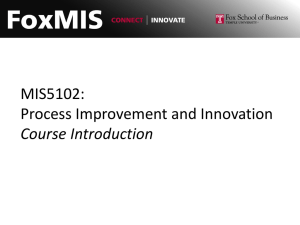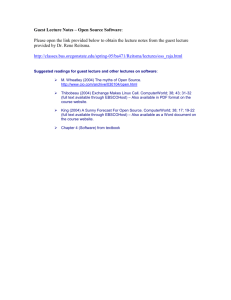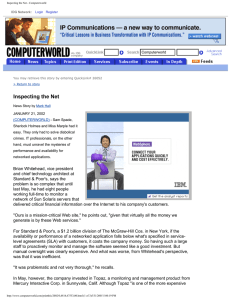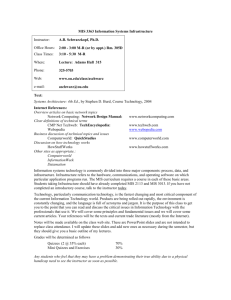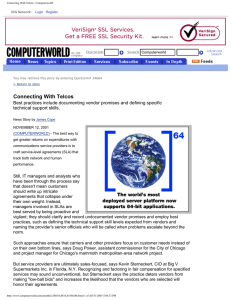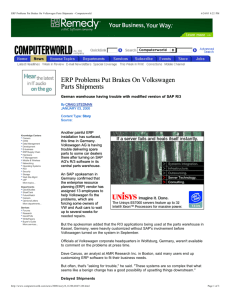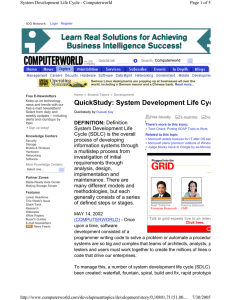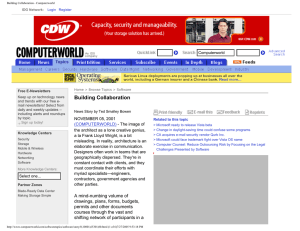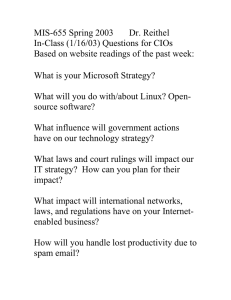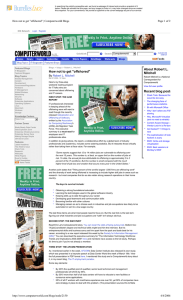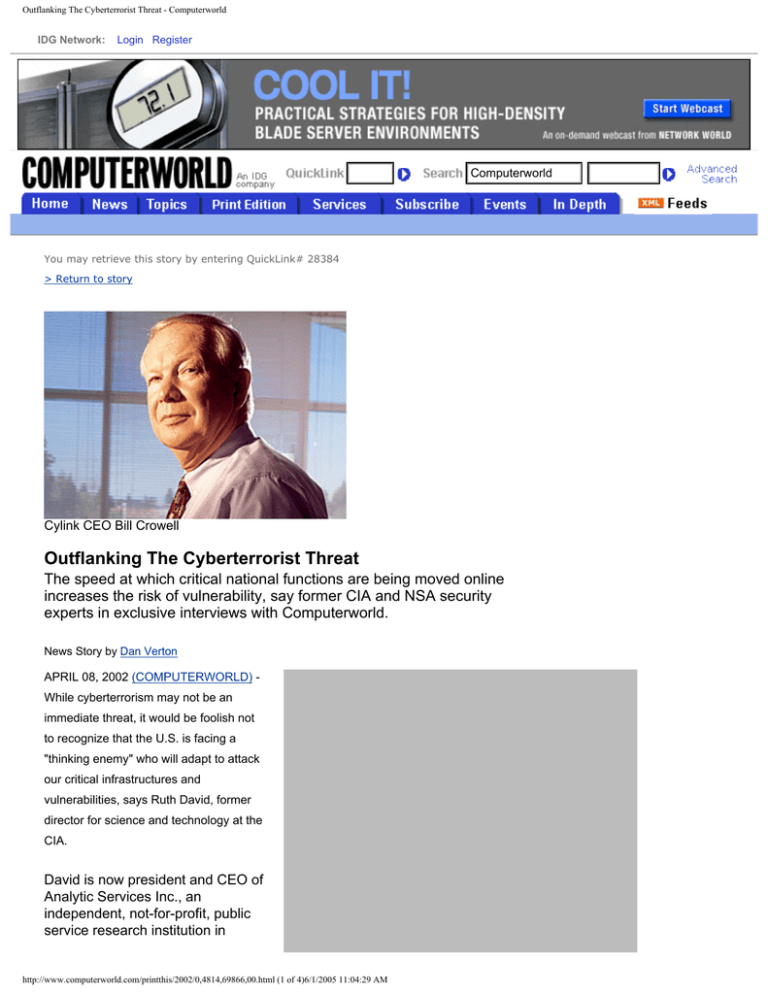
Outflanking The Cyberterrorist Threat - Computerworld
IDG Network:
Login Register
Computerworld
You may retrieve this story by entering QuickLink# 28384
> Return to story
Cylink CEO Bill Crowell
Outflanking The Cyberterrorist Threat
The speed at which critical national functions are being moved online
increases the risk of vulnerability, say former CIA and NSA security
experts in exclusive interviews with Computerworld.
News Story by Dan Verton
APRIL 08, 2002 (COMPUTERWORLD) While cyberterrorism may not be an
immediate threat, it would be foolish not
to recognize that the U.S. is facing a
"thinking enemy" who will adapt to attack
our critical infrastructures and
vulnerabilities, says Ruth David, former
director for science and technology at the
CIA.
David is now president and CEO of
Analytic Services Inc., an
independent, not-for-profit, public
service research institution in
http://www.computerworld.com/printthis/2002/0,4814,69866,00.html (1 of 4)6/1/2005 11:04:29 AM
Outflanking The Cyberterrorist Threat - Computerworld
Arlington, Va. She and Bill Crowell,
CEO of Santa Clara, Calif.-based
security firm Cylink Corp. and a
former deputy director of the
supersecret National Security
Agency, each participated in rare
interviews with Computerworld's
Dan Verton. They discussed the
threats posed by cyberterrorist
attacks and the steps that the
public and private sectors should
take to thwart them.
There's been speculation, even
before Sept. 11, about the U.S.'s
vulnerability to an "electronic
Pearl Harbor" or cyberterrorist
attack. How has this changed since Sept. 11, and how vulnerable are the various
economic sectors to cyberterrorist attacks?
David: While it is true that major terrorist attacks to date have targeted human lives, I would
not blindly extrapolate that behavior into the future. After all, on Sept. 10, we would not have
expected a hijacker to turn a commercial airplane full of passengers into a guided missile, and
even on Sept. 12, we did not envision exploding shoes as a threat to aviation.
In the aftermath of the 9/11 attacks, those adversaries almost certainly observed the
immediate effect of service interruptions as well as the prolonged economic impact of
infrastructure disruptions. While the weapon used was explosive rather than cyber, it doesn't
take much imagination to see that similar effects could be achieved through cyberterrorism.
Crowell: Clearly, the vulnerabilities of the nation to cyberattack are growing. Critical national
functions like banking, financial services, health, water and communications are increasingly
dependent on highly automated systems that connect the many nodes of their operations.
These changes in the degree to which business and the government are dependent on public
networks have been occurring for about a decade. The disturbing thing is that all of the trends
are in the wrong direction. Business is moving more and more critical functions to networks.
The speed and complexity of the deployments make it difficult for them to employ good
defenses rapidly. Diversity is decreasing as we migrate more to common operating systems
and common network systems.
To what extent is the war on terrorism, particularly the battle for improved homeland
security, a technology problem? What roles do you see the government, corporate
America and the IT vendor/developer community playing?
David: Technology is only one component. Without supporting policy, effective processes and
well-trained people, technologies solve nothing. Deployment of facial recognition technologies
at border entry points will not ensure apprehension of terrorists.
Corporate America will play an increasingly important role in developing security technologies
to protect nongovernmental personnel and property that may be targeted by terrorists
attacking what we are as a nation rather than what we do as a government.
http://www.computerworld.com/printthis/2002/0,4814,69866,00.html (2 of 4)6/1/2005 11:04:29 AM
Outflanking The Cyberterrorist Threat - Computerworld
Crowell: The battle for improved homeland security involves both technology and processes.
Technology can be used to make the processes more efficient, predictable and effective.
The Transportation Security Agency, [Federal Aviation Administration] and Department of
Transportation are all looking for ways to improve [airport security]. However, I am particularly
concerned that many of the critical processes are now using technologies that are more
vulnerable, not less. An example is the use of wireless LANs for the tracking of baggage.
Without proper encryption and authentication, the baggage handling system will not prevent
either insider or outside attack.
Some have said that the government's push to create a separate and secure intranet
(GovNet) for sensitive government operations and possibly e-commerce is tantamount
to throwing in the towel on Internet security. Are there viable alternatives to
disconnecting from the Internet?
David: To the extent that terrorists attack symbols of America, seek to shake the confidence of
the public in our government's ability to protect [citizens], and/or seek to inflict economic
damage, GovNet solves nothing, since many valuable cybertargets would be left undefended.
In fact, a separate network might actually impede the homeland security mission since it could
further isolate government from industry and the American public at a time when
communication and collaboration are desperately needed.
In particular, I believe the absence of a coherent governmentwide security policy has
significantly limited our ability to protect sensitive government operations.
Crowell: I think that the GovNet initiative has been misrepresented in the press. Perhaps this
is because the government did not carefully lay out the principles in the beginning of the
discussion. [The government has] advocated that the core mission systems be on separate
private networks that are highly protected from denial-of-service attacks and from hacking and
cyberattacks.
The Internet would be used for e-government to enjoy the enormous reach it provides to the
public. These are not new concepts. In banking and financial services, these policies have
long been the basis for their risk management practices.
Howard Schmidt, the deputy chairman of the President's Critical Infrastructure
Protection Board, said recently that the next national plan for protecting the country's
critical systems and networks will be written with the help of the private sector. What do
you think the immediate priorities and focus should be for such a public/ private plan?
David: If I were to offer a top priority, it would be to establish trust between government and
industry and among the key industry sectors. This means first and foremost to create a safe
environment for the sharing and analysis of information regarding cyberattacks and discovered
vulnerabilities.
My next priority would be to bolster our intrusion-detection capabilities. I worry less about the
overt attacks that disrupt service than the subtle attacks designed to steal or corrupt data attacks that may go undetected until disaster occurs.
Crowell: I think that there are two elements that should be part of the plan. The first is that the
government should be a leader in network security and move quickly to employ the best
practices for both GovNet and e-government. The second is that the [Securities and Exchange
Commission] should establish the same risk disclosure rules for network security that it used
http://www.computerworld.com/printthis/2002/0,4814,69866,00.html (3 of 4)6/1/2005 11:04:29 AM
Outflanking The Cyberterrorist Threat - Computerworld
to focus attention on Y2k and on disaster recovery.
Without such a mechanism, there is a strong likelihood that the vulnerabilities and risks in
network-based business won't get the attention that [they need] until there is a disastrous
event. I think that the disaster recovery systems of the financial businesses in the World Trade
Center saved many of them from total collapse.
Read accompanying story:
●
Terrorism 101 With Eric Shaw
Image credit:
John Harding
Copyright © 2005 Computerworld Inc. All rights reserved. Reproduction in whole or in part in any form or medium without express written permission of
Computerworld Inc. is prohibited. Computerworld and Computerworld.com and the respective logos are trademarks of International Data Group Inc.
http://www.computerworld.com/printthis/2002/0,4814,69866,00.html (4 of 4)6/1/2005 11:04:29 AM

